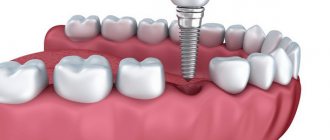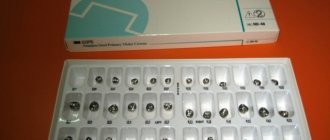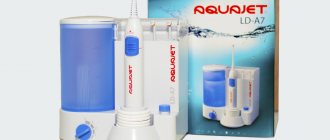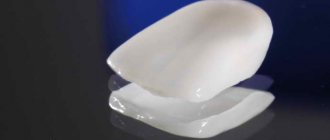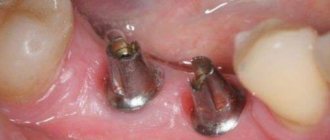- Types of veneers
- In what cases are veneers installed?
- How long do zirconium veneers last?
- How does the installation work?
- Advantages and disadvantages of zirconium veneers
- Rules of care
Veneers are used to restore the aesthetics of the front part of the dentition. Microprostheses, which look like thin plates, can hide cracks and chips of enamel, darkening, even out the length of teeth, and eliminate slight curvature. Veneers belong to the section of aesthetic dentistry. The onlays made of zirconium are strong, durable and very aesthetically pleasing.
Types of veneers
Veneers vary in manufacturing principle and material, cost, and durability.
- Composite veneers. The most inexpensive and simplest option. If there are two manufacturing options: in one visit, directly in the patient’s mouth or using impressions in a dental laboratory. There are several disadvantages. First of all, these are issues of aesthetics, durability and strength. Composite is a common filling material. Over time, it will inevitably change color, and the likelihood of chipping is also high. When making such veneers in the dentist's chair, difficulties arise with working out the contact area near the gums. Composite veneers, which are made in a laboratory, provide higher results in terms of strength, but are also inferior to more expensive options - zirconium and ceramic veneers.
- Imax/Emax veneers are the most aesthetically pleasing and allow you to correct your teeth in one visit to the doctor.
- Porcelain veneers. These are the thinnest plates, not exceeding 0.5 mm in thickness. Their aesthetics are very high, moreover, the plates do not suffer from the effects of coloring and aggressive substances, do not wear off, and do not change color.
- Zirconium veneers. Very durable and aesthetic. This is a new word in the field of dentistry; the properties of the material determine the excellent appearance and the highest strength of the elements. The only drawback of restoration with zirconium veneers is the rather high cost compared to composites. Thus, the price for zirconium veneers in Moscow in 2020 starts from 11,500 rubles per unit.
Until recently, ceramic veneers were the leaders in properties and popularity. With the advent of zirconium dioxide, the situation changed and ceramics faded into the background. The material can be used even in the most difficult cases and has no contraindications.
Peculiarities
Previously, zirconium dioxide veneers were practically not used.
Preference was given to porcelain dental onlays, which were distinguished by their relative durability and whiteness.
But during wearing, shortcomings of this material were increasingly discovered, which manifested themselves in small cracks and defects or even cracked from hard food.
This prompted the search for a stronger substance that could be used for dental purposes. As a result, it was decided to use zirconium, which has proven itself to be a strong and durable material that does not cause a negative reaction in humans.
In addition, they are not allergenic and do not come into active contact with acids and alkalis.
The main feature of zirconium veneers is that they retain their color throughout their entire service life.
Due to the fact that they do not react with various dyes that may be contained in food, the preservation of teeth whiteness is guaranteed.
It is worth noting that after installing such microprostheses, it is impossible to distinguish them from natural dentition. Its reaction with metals allows you to create a prosthesis of a specific color that will best suit a particular case.
Veneers are often installed that are very noticeable. Therefore, a method of creating veneers using a combination of zirconium and porcelain is being considered.
First, a so-called zirconium dioxide frame is created, on which porcelain is placed on top. Thus, several goals are achieved at once - a spectacular appearance and durability.
In what cases are veneers installed?
There are several dental problems that zirconium veneers can address:
- Slight crooked teeth.
- Aesthetic problems in the smile area - chips and cracks of enamel.
- Darkening of teeth after depulpation, use of medications, diseases.
- Fluorosis, which causes stains on the enamel.
- Gaps between teeth.
- Old fillings on the front surface of the teeth.
Contraindications to installation of zirconium veneers
- Significant malocclusion.
- Bruxism.
- Significant tooth decay, large filling on the inner surface (a crown can be installed on such a tooth).
- Strong abrasion of enamel.
- Darkening after using resorcinol.
- Lack of chewing teeth.
Also, veneers are not installed in the presence of caries, inflammatory gum diseases, or periodontal disease.
Indications and contraindications
Any change in the human body through external intervention affects its processes. They can be completely invisible, or they can demand attention to themselves. Therefore, with any such action, you should study this issue yourself and consult with a specialist in this field. Zirconium veneers have a number of indications and contraindications.
You need to start wearing veneers in the following situations:
- there are various damages to the enamel, including cracks in the teeth;
- large gaps have formed between the teeth;
- increased sensitivity of teeth associated with deviations in enamel;
- curvature of teeth, which can lead to complications;
- irregularities in the coloring of teeth for various reasons that cannot be corrected by whitening.
It is worth understanding that the installation and subsequent wearing of veneers is not a treatment process, but rather is responsible for the aesthetic side.
Indeed, by installing veneers, the smile becomes much more impressive and luxurious, but the teeth underneath them must be free from all diseases, problems or abnormalities. Veneers act as a kind of external armor, which should protect the healthy core, and therefore there are a number of contraindications.
Zirconium veneers cannot be installed if:
- there are severe anomalies in the position of the teeth in the row, requiring surgical intervention;
- violations of basic oral hygiene rules;
- various diseases requiring medical intervention and special treatment;
- sizes of dental crowns that do not allow microprostheses to be attached to them.
Read also: What are inlays for prosthetic teeth?
Basic contraindications consist of situations that can be solved by a specific treatment. This once again confirms that the installation of zirconium veneers is not of a therapeutic nature, but rather requires special preparation.
How does the installation work?
Before we talk about installing veneers, a consultation, examination, and some research are carried out. The specialist determines the possibility of installing veneers, assesses the presence of contraindications, and develops the course of treatment. The installation takes place over several visits and involves a number of stages:
- Choosing the shade of future plates. It can completely match the patient’s natural enamel tone or be lighter as desired.
- Preparing teeth – grinding, removing excess tissue. This is necessary so that the teeth do not look too large or voluminous after the plates are installed.
- Taking impressions, obtaining information for subsequent modeling of veneers.
- The surface of the treated teeth is covered with composite onlays. This is a temporary measure that allows you to protect your teeth and relieve excessive sensitivity.
- Making records.
- Removing protective covers, trying on finished products.
- Installation of veneers.
How are zirconia veneers installed?
Before installing zirconium veneers on your teeth, you should definitely consider all options with your doctor, since only he can advise what is most suitable for a particular patient, based on his individual characteristics. Please note that veneers serve solely to hide defects, and the installation procedure has nothing to do with treatment. Therefore, it is important to understand that before installation, the patient must necessarily treat diseases of the oral cavity, otherwise it will be impossible to prevent the development of pathological processes in time - their signs will be completely masked by the onlays.
6 installation steps
- A complete check of the condition of the teeth and, if necessary, comprehensive treatment.
- Selecting the shade and shape of the plates.
- Grinding of tooth enamel to the thickness of the veneer (before installing a permanent veneer, the patient can wear temporary composite onlays).
- Taking a three-dimensional impression, on the basis of which structures will be made.
- Production of individual records.
- Removal of temporary onlays, treatment with an antiseptic and fixation of zirconium veneer using special cement.
Advantages and disadvantages of zirconium veneers
Let's consider the advantages:
- Beauty, a very high level of aesthetics.
- Immunity to plaque and dyes, maintaining a perfect smile for as long as possible.
- High strength, ability to withstand heavy loads.
- Full biocompatibility. The material does not cause allergies and cannot be rejected by the body.
- Can be used in complex clinical cases, with a minimum of contraindications.
- Resistant to temperature changes. The change from hot to cold and vice versa will not harm the plates.
Veneers also have disadvantages. Among them:
- Inevitable grinding of tooth tissue. That is, the teeth are damaged and after removing the veneers it will not be possible to simply leave everything as is. It will be necessary to either replace the linings with new ones, or a cheaper and less successful analogue - composite restoration.
- Quite a lengthy installation procedure.
- High price.
- Veneers do not strengthen teeth, but only give them an aesthetic appearance.
- The patient must constantly remember that he has thin linings on his teeth that can be damaged.
The average cost of zirconium veneers in Moscow is from 11,500 rubles to 25,000 rubles.
Installation technique
Any veneers are installed through the painstaking work of a specialist.
Zirconium veneers, in turn, require much more time.
On average, with a normal oral cavity, you will have to visit the dentist three times.
At the first appointment, the specialist needs to make sure that there are no contraindications, and that there are no problems that require immediate elimination.
If there are minor shortcomings, then he advises on the actions that need to be taken before the next appointment.
Having eliminated all the nuances, a second visit is carried out, which consists of turning the enamel (removing its top layer). The procedure is performed under anesthesia and is necessary in order to subsequently take measurements to create future prostheses.
To prevent the attachment of the plates from causing an increase in the volume of the jaw and unpleasant sensations, they should be attached to the place of the enamel layer that was previously removed. At the end of the second appointment with the doctor, which consisted of creating an impression of the future veneers, temporary plastic veneers are installed on the teeth subject to treatment for protection until the next visit.
When deciding to install zirconium veneers, as a rule, the time interval between the second and third doctor’s appointments can be long. This is due to the complexity of the process of creating such veneers, despite the fact that they are produced with special equipment.
At the third appointment, the plates are directly attached to the tooth surface. For this, a special solution (cement) is used. It is characterized by a unique composition that makes it durable and eliminates interaction with alkalis and acids.
Cement has no effect on taste and color.
Before applying the solution and attaching the plate, the tooth surface is treated with antiseptic and disinfectants.
After attaching the veneer, excess cement is removed. It is not advisable to eat or drink water for the next few hours.
Due to the complexity of creating zirconium veneers and attaching them to the tooth surface, the cost is not affordable.
In addition, this type of veneer is characterized as a novelty in the field of dentistry and is created using the latest technologies.
In order to create a final microprosthesis based on a 3D impression, which will be worn in the future, it is necessary to use certain equipment developed specifically for this by the world's best scientists. This is far from a cheap machine, and therefore not every dental institution can afford it.
Prices for zirconium veneers average in the $100 range. Of course, each clinic has the right to set its own price range, depending on the availability and use of equipment, the cost of a specialist’s work, and the condition of the teeth before bonding.
Since each case is individual, the result of the procedure may vary. Due to the active growth in popularity of zirconium dioxide veneers, opinions about them have begun to be expressed more and more actively.
For the most part, reviews about zirconium veneers can be described as positive, since the new type of smile has increased many people’s self-confidence and desire to smile.
As for the negative ones, they are also present and are caused mainly by the high cost and duration of the process. Many people express their complaints regarding the time between removing the enamel and attaching the veneer.
Of course, this is not a very pleasant moment and indeed other types of veneers do not require waiting so long. But after enduring this difficult period, you can safely enjoy your new fabulous smile.
Rules of care
Immediately after installation and for several hours you should not eat or drink anything. In general, if installed correctly, veneers simply become part of the teeth and care is not complicated in any way.
- You need to brush your teeth at least twice a day, use dental floss, and rinse to clean your mouth.
- You should visit the dentist at least every six months.
- If excessive sensitivity and other unpleasant symptoms appear, you should consult a doctor to solve the problem.
With careful handling and a guaranteed level of quality from a professional, veneers will last 15 years or more.
Author:
Mayorov Andrey Mikhailovich
Specialization:
orthopedic dentistry, dental prosthetics, implant installation
Installation procedure
Before proceeding with the procedure, the patient must attend a consultation and undergo a full examination at the clinic. If the dentist finds diseases of the oral cavity (caries and others), comprehensive treatment is prescribed. Next, the dentist:
- Selects the shade and shape of the plate.
- Grinds down tooth enamel to the thickness of a veneer.
- Takes a three-dimensional impression and produces custom plates.
- Removes temporary onlays, treats the surface of the teeth with antiseptic agents and fixes zirconium veneers with cement to the tooth.
After the procedure, you must abstain from drinking and eating for several hours.
There are no further restrictions. It is recommended to provide timely oral care using floss (2 times a day). Important! The average lifespan of solid zirconia veneers is more than 15 years.
If zirconium-based overlays with ceramic coating were used - more than 10 years. If you follow the rules of safety and dental care, do not forget about regular dental examinations (2 times a year). If you look at the reviews, almost all clients like zirconium dioxide dental onlays. Veneers help hide all dental defects, reduce sensitivity and make a snow-white, natural smile. Detailed information and answers to questions are posted on the StomInfo website -.
Calculator: calculate prices online
Calculation of the cost of turnkey veneers
Calculate the cost of installing veneers yourself.
For an accurate final calculation, the cost of fixation is added to each veneer - 500 rubles. and once for the entire work, the cost of casts is 1200 rubles.
Choose the type of veneers
0
Please indicate the required number of veneers
Better and more accurate - in a free consultation! All addresses and telephone numbers are on the website chudostom.ru. Make an appointment by calling the branch closest to you.
The calculation is not a public offer; the final cost is determined at a free consultation BEFORE the start and does not change during the treatment process.
Total cost rub.
0
Installation steps
We work in several stages
:
- We are conducting an inspection. If necessary, we change old fillings, treat caries, remove plaque and stone, which is paid for separately.
- We carry out turning and take 3D impressions. After this, we install temporary overlays and choose the color of the dentures with the patient.
- We send the task to the dental laboratory. Based on the casts, we create a three-dimensional computer model and turn them on a milling machine.
- We remove the pads, treat them with an antiseptic, and attach the dentures using special glue. We install zirconium veneers only on the front teeth (in rare cases, on the first chewing teeth), since the material is not resistant to increased load.
Indications
Microprostheses are manufactured in laboratory conditions using robotic CAD/CAM equipment, which reduces the risk of human errors to zero. ICE Zircon based onlays provide enhanced veneer strength in segments exposed to high chewing loads.
Prettau technology makes it possible to manufacture an all-zirconium microprosthesis, which is used in difficult clinical situations. These features of zirconium veneers allow them to be used in very difficult cases:
- cracks;
- enamel chips;
- large gaps between the front teeth;
- underdeveloped/hypersensitive enamel;
- curvatures of 1-2 degrees;
- complex color defects: fluorosis, yellowing, dark spots;
- "tetracycline" organs;
- anomalies of shape that require aesthetic correction.
| view from right to | front view before | view from left to | ||||
| right view after | front view after | left view after | ||||
Dentures are installed on the central group of teeth, less often on premolars; they are not fixed on chewing units in order to avoid peeling off due to heavy load.
Minuses
The disadvantages of onlays made on zirconium dioxide are that:
- Veneers are very expensive.
- The production of plates is technically difficult, as they require high precision, and the material itself is difficult to fix to the tooth.
- The manufacture of overlays requires special, expensive equipment.
- When installing a zirconium veneer, there is a need for more significant grinding of the tooth.
- If you don't care for your teeth properly, the plates can break or peel off. In case of normal detachment of the structure, it can be returned to its place. If a record breaks, you cannot do without making a new one.
- The impossibility of restoring the original appearance of teeth after installing onlays.
A contraindication to the installation of veneers may be
- Bruxism (a person grinds his teeth in his sleep);
- insufficient amount of tooth enamel;
- teeth have not erupted sufficiently;
- pathology of the bite, for example straight or deep
- severe forms of caries;
- the presence of gum diseases, such as periodontal disease, periodontitis or gingivitis (first you will need to eliminate all existing problems);
Also, fragility of the teeth or the presence of large fillings may serve as contraindications to the installation of veneers. Despite the fact that the plates are made of durable material, this is not enough to protect the tooth from destruction. In such cases, it is better to use dental crowns.
Important! The uniqueness of zirconium dioxide lies in its stability. Numerous experiments involving chemical reagents have shown that it is not afraid of moisture and is resistant to alkaline and acidic environments. Another property of zirconium is the ability to match it to any shade of enamel.
Advantages and disadvantages
Like any dental material, zirconium has advantages and disadvantages. You can learn about them from patients who have had dental veneers made from this material.
Pros:
- a thin plate preserves the natural shine of teeth;
- the shape and shade are not distorted over many years of use;
- coloring pigments from food and drinks do not penetrate the material;
- zirconium is completely compatible with the human body, therefore it does not cause allergic reactions and is not rejected;
- resistant to temperature changes, therefore do not require special dietary restrictions;
- completely adjacent to the enamel, which reduces the likelihood of the formation of carious cavities;
- durable and can withstand various types of chewing loads;
- last more than 10 years, eliminating the need for regular replacement.
Minuses:
- high cost of material;
- long production;
- the need for maximum tooth grinding;
- inability to return to the original state of the teeth after removing the material.
